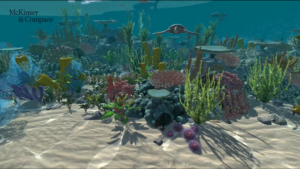
Understanding the McKinsey Problem Solving Game (PSG) Scoring (Latest update 2023)
In the realm of job assessments and recruitment, McKinsey & Company, a renowned global management consulting firm, has introduced an
In the realm of job assessments and recruitment, McKinsey & Company, a renowned global management consulting firm, has introduced an innovative evaluation method to gauge candidates’ aptitude and problem-solving abilities. The Redrock Study, a captivating game within the McKinsey Solve framework, is specifically designed to test these skills. This article delves into the intricacies of the Redrock Study, offering insights into its purpose, structure, and expert strategies to help you conquer this unique challenge.
The Redrock Study stands as the newest addition to McKinsey Problem Solving Game (PSG) lineup. This assessment serves as a distinctive tool to evaluate candidates’ problem-solving capabilities within a simulated research context. Diverging from previous assessments, which were rooted in consulting and business frameworks, the Redrock Study removes the requirement for specific business knowledge. This shift allows for an unbiased evaluation of candidates, focusing solely on their problem-solving skills, regardless of their domain expertise.
As of March 2023, Redrock Study has undergone updates and can now be completed within 35 minutes. This time is divided into four distinct sections, with the final section featuring a mini-case comprising ten quantitative reasoning questions. The inclusion of these case questions has heightened the difficulty level, as candidates must manage their time effectively to tackle both the study segment and the case questions within the given timeframe.
The Investigation stage initiates the assessment, providing candidates with a comprehensive case description. The primary objective is to identify and extract the most relevant data points from a vast sea of information. It is crucial to save these vital pieces of information in the Research Journal, as access to the original data is limited in subsequent stages. To navigate this section effectively, consider the following steps:
The Analysis stage presents candidates with three numerical questions. These questions require the application of basic mathematical concepts such as percentages, weighted calculations, compound percentages, and probability. The game provides an on-screen calculation tool to process the data collected. To excel in this section, follow these steps:
The Report stage serves as the culmination of the Redrock Study, where candidates utilize the results obtained from the Analysis stage to create reports in both textual and graphical formats. This stage emphasizes the ability to interpret data effectively and demonstrate relationships between different data points.
The Case Questions section is the newest addition to the Redrock Study. It features ten individual case questions that test candidates’ quantitative reasoning skills. These questions require analyzing information from various charts (such as pie, bar, and line graphs) and text paragraphs. Quick and accurate data interpretation, along with strong quantitative and analytical skills, are key to success in this section.
With the updated version of Redrock Study, candidates now have a total of 35 minutes to complete both the study segment and the ten quantitative reasoning questions. Time management is critical, and it is recommended to allocate equal time to the Investigation-Analysis-Report part and the Case Questions for optimal performance.
To summarize, achieving success in the Redrock Study requires a strategic approach and honed problem-solving skills. Here are the key takeaways to guide you on your journey:
Approach each stage with a researcher’s mindset, focusing on the objective and collecting relevant information. By adopting this perspective, you’ll be better equipped to handle the challenges presented in Redrock Study
During the Investigation stage, aim to collect key data points efficiently. Be selective and discerning in choosing numerical data for your Research Journal. Renaming the items to include essential features will help prevent confusion during subsequent stages.
The Analysis stage tests your numerical reasoning skills. Pay attention to the types of calculations involved, such as percentages, compound percentages, weighted calculations, and probability. Utilize the on-screen calculation tool effectively and record your answers in the Research Journal for future use.
In the Report stage, both the Documental and Graphical Reports require clarity and precision. Ensure you have a solid grasp of the results obtained from the Analysis stage. Utilize the calculated data to complete the textual report accurately. When creating the graphical report, select the most suitable chart type to effectively visualize the data.
The Case Questions section demands strong quantitative and analytical skills. Quickly analyze and interpret information from charts and text paragraphs to set up calculations and arrive at correct answers. Efficient time management is crucial, given the limited time frame. Aim to allocate equal time to the Investigation-Analysis-Report part and the Case Questions.
In conclusion, the Redrock Study is a challenging and engaging assessment within the McKinsey Solve game. By understanding the different stages and applying the recommended strategies, you’ll be well-prepared to tackle this unique problem-solving experience. Embrace the researcher’s mindset, collect and process data efficiently, master numerical reasoning, create clear and concise reports, and tackle the case questions strategically. With these skills in your arsenal, you’ll be ready to conquer the Redrock Study and showcase your problem-solving prowess. Good luck on your journey towards success!
To further support McKinsey candidates, we have developed a PSG Redrock Simulation that closely resembles the real Solve game, with a 95% similarity rate. This simulation is designed to prepare you for the actual test, mirroring the format, interface, and logic of the McKinsey PSG. With realistic simulations and comprehensive guidebooks, our package enhances your chances of success in the Redrock minigame within the McKinsey Solve game.

In the realm of job assessments and recruitment, McKinsey & Company, a renowned global management consulting firm, has introduced an

This article aims to provide you with valuable tips and strategies to help you master the Ecosystem Building game and

Avoid These Common Mistakes in the McKinsey Problem-Solving Game (PSG) Facebook Reddit Twitter LinkedIn WhatsApp Table of Contents Brief overview